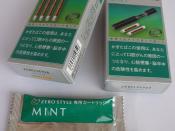Smokeless Tobacco A Rising Trend with Today's Youth By July 3, 2001 Abstract The consumption of tobacco is probably the most harmful thing you can do to your body and health. Most people that consume tobacco do so in the form of a cigarette, but lately there has been another form of tobacco that is cause for concern among younger age groups: smokeless tobacco. Smokeless tobacco contains the same addictive nicotine found in a cigarette but it is chewed rather than smoked. The tobacco or plug sold in pouches is a long thick strand of tobacco. Smokeless tobacco is also available as moist snuff, which is a moist fine grain loose tobacco that is sold in cans. The tobacco is placed in the mouth between the cheek and gum and sucked. The chewing action releases the nicotine. snuff, which is a moist fine grain loose tobacco that is sold in cans.
The user of snuff takes a "dip" which is place in the cheek and sucked upon. This sucking action releases the nicotine the same as a plug. Smokeless tobacco users enjoy the sensation of the tobacco in the mouth and the saliva that it produces. The excess saliva is then not swallowed but spit out because it can cause stomach irritation. This repeat process of spitting is an addiction on it's own and is a tradition that has been around for hundreds of years among some groups such as baseball players.
Smokeless Tobacco A Rising Trend with Today's Youth Static's reported by the The American Cancer Society recently reported that over 12 million people use some form of smokeless tobacco with a growing trend in tobacco use among young people especially among young white males. Traditionally, smokeless tobacco was thought to be more popular in the rural south. Recently the group with the biggest increase in smokeless tobacco use has been among children 8-17 years old. Findings from the National Youth Tobacco Survey showed that 12.8% of all tobacco usage is among middle school students and 34.8% among high school students. A study conducted by the American Legacy Foundation on January 28, 2000, found that 4.2% of middle school boys and 11.6% of high school boys use smokeless tobacco. Herb Severson, Ph.D., a scientist at the Oregon Research Institute reported that the average age of smokeless tobacco use is 12, two years younger than the age for cigarette use in his article Addicted to Dipping. Upward trends in the use of smokeless tobacco by younger consumers are thought to be caused by the exploitation of athletes using smokeless tobacco. This is especially true with baseball players. Tobacco companies are sponsoring sporting events like rodeos, truck rallies, and car racing, which are geared to attract the young male consumer. Smokeless tobacco manufactures also advertise in hunting and fishing and game sports related periodicals. These types of publications are marketed specifically toward young men who can become addicted to the product at an early age and become long-term smokeless tobacco users.
Socially Unacceptable In 1997 a survey conducted by the National Household Survey on Drug Abuse found that 92% of those who used smokeless tobacco were male. This means that 8% of the smokeless tobacco population was female. The ratio could be attributed to many work environments becoming smokeless. Nicotine addicts must obtain the substance in other ways such as smokeless tobacco. According to the article Addicted to Dipping by Jim Dawson, dentists have seen an increased use of smokeless tobacco among people who can no longer smoke on the job. Also, because of the attention that second hand smoke has received in the media, tobacco smokers have taken up the habit of smokeless tobacoo use so that they can attend functions and not expose nonsmokers to smoke.
Health Issues The largest concern with the use of smokeless tobacco use is cancer. The U.S. Department of Health and Human Services reports that tobacco snuff contains the organic carcinogen nitrosonornicotine (NNN), which produces malignant tumors in the trachea, esophagus, liver, and oral cavity. Smokeless tobacco also contains three other carcinogens: Nitrosamines, polycyclic aromatic hydrocarbons, and polonium 210. These carcinogens increase the chance of cheek and gum cancer by 50% and cause about 28,000 new cases of oral cancer a year (Severson). The use of smokeless tobacco also can cause gum recession: A condition where the gums wear away from the teeth, and bone loss in the jaw occurs. Prolonged use and exposure to smokeless tobacco can lead to the teeth becoming week, badly discolored and possibly tooth loss can occur. Long-term use of smokeless tobacco increases the risk on cancer of the gum and cheek as much as 50 percent (CDHA/ACHD).
Why Don't They Quit? The nicotine found in tobacco is highly addictive and has been reported to be as addictive as Heroine. Severson reported that the rate for quitting smokeless tobacco successfully was about the same as with cigarettes: 10-12% of quitters are successful for many years. Once a tobacco user is addicted it is almost guaranteed that they will become a user for life. The nicotine found in one can of snuff is equal to two packs or sixty cigarettes. Smokeless tobacco users that try to quit their habit suffer withdrawal symptoms that are both physical and psychological in nature. No wonder the smokeless tobacco industry is such big business.
More than $127 million was spent advertising smokeless tobacco products in 1995, according to a Federal Trade Commission (FTC) report to Congress. Revenues from smokeless tobacco sales exceeded $1.7 billion in 1995. More pounds of loose leaf/chewing tobacco were sold in 1994 and 1995 than any other type of smokeless tobacco. However, advertising expenses for moist snuff exceeded expenditures for all other types of smokeless tobacco combined $82 million in 1995. Moist snuff also had the highest revenues with 1.3 billion in 1995.
Withdrawal symptoms from smokeless tobacco can include depression, frustration, irritability, trouble sleeping, headache, and increased appetite. These are all similar to withdrawal of cigarette smoking (ACS). Prescription drugs, such as Zygan, can help addicts quit using smokeless tobacco and relieve some of the withdrawal symptoms. Patches and special chewing gums that contain nicotine can also be used to aid in relieving the withdrawal symptoms. Still the addiction to nicotine is strong and it is not something that is easy to give up.
Organizations such as the American Association of Pediatrics and other child advocacy groups strongly encourage parents to be aware of the dangers of smokeless tobacco and to discourage its use. Only through the work of these groups and the growing awareness of the dangers of all forms of tobacco will its use stop.
References éAmerican Academy of Pediatrics. Caring for Your School-Age Child: Ages 5 to 12, Bantam Books;1995.
Center for Disease Control Tobacco Info, National Center for Tobacco-Free Kids. Campaign for Tobacco Free Kids Factsheets .
Center for Disease Control. Youth Tobacco Surveillance. CDC Morbidity and Mortality Weekly Report, Oct. 2000, Oct 13: vol. 49 (10), pp. 1-94 CDC Morbidity and Mortality Weekly Report (MMWR). Youth Risk Behavior Surveillance, September 27, 1996 Issue.



![Cigar, smoking tobacco, cut tobacco, cigarettes, Raleigh O&R [front]](https://s.writework.com/uploads/11/119428/cigar-smoking-tobacco-cut-tobacco-cigarettes-raleigh-o-r-fro-thumb.jpg)

